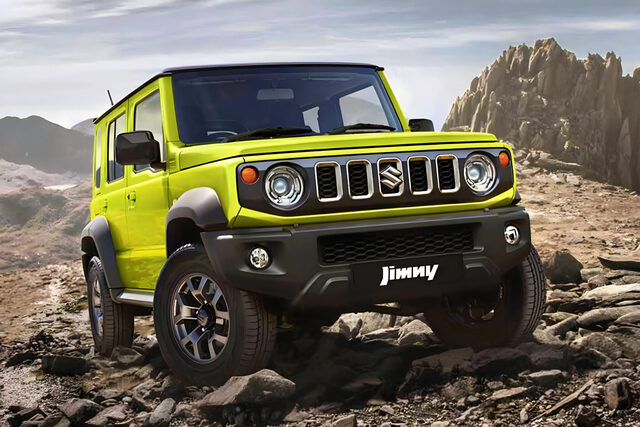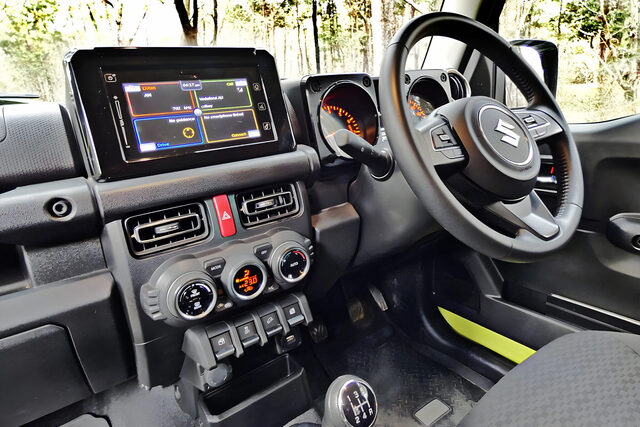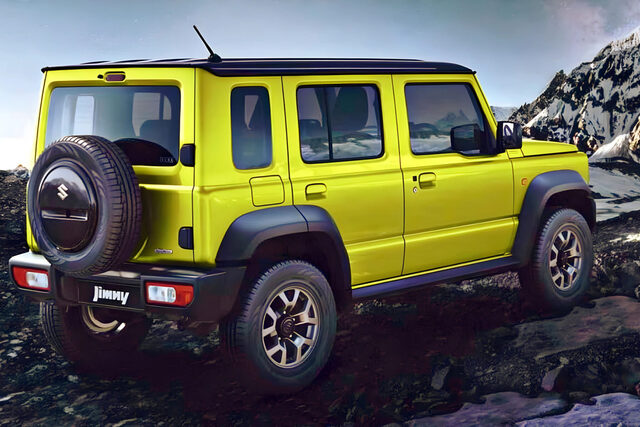
A five-door version of the Suzuki Jimny. Who would have thunk?
It should make getting in and out of the back a little easier, not that you would want to volunteer to sit in the back.
And not that the Jimny XL (that’s what it is designated as) is likely to offer that much more legroom than its sibling, but let’s crunch the numbers and find out.
STYLING
From the front there’s little to tell the three- and five-door versions of the Jimny apart.
Both feature Suzuki’s stylised five-slot radiator grille, but in the case of the five-door it’s black with chrome accents.
Looks a bit like the seven-slot grille that Jeep is famous for, but while others have got into trouble for copying the design Suzuki seems to have escaped attention.
At the rear the spare wheel sits on the tailgate which has two open positions for ease of loading in restricted spaces.
Essentially, the five-door Jimny will set you back $3000 more than its smaller sibling.
Jimny three-door starts from $34,990 for the Lite; the fully equipped Jimny from $36,490.
Jimny five-door starts from $39,490 for the 1.5 XL AWD manual; the auto adds $2500. There’s also a Heritage model priced from $40,990.
These prices are driveaway.
Our test vehicle was the $39,490 XL manual. Premium paint is $745 extra or two-tone paint with a different coloured roof will set you back $1345.
There are six colour choices, two of them combos: Chiffon Ivory Metallic/Bluish Black Pearl or Sizzling Red Metallic/Bluish Black Pearl.
Standalone colours include Arctic White Pearl, Bluish Black Pearl, Granite Grey Metallic and Jungle Green.
Other accessories that might be of interest include front and rear diff guards at $801 apiece, a bike carrier is $526, ski/snowboard carrier $468 and surfboard carrier $372.
Standard kit includes 15-inch alloys, cloth trim, single zone climate control air conditioning, leather-covered steering wheel, keyless entry and push-button start, adaptive cruise control, auto high beam, dusk-sensing LED headlights, front fog lights, Daytime Running Lights (DRLs), privacy glass, rear parking sensors and traffic sign recognition.
A full-size alloy spare sits on the tailgate, with a centre cover (we think the cover is standard).
Jimny five-door, like its little brother, is covered by Suzuki’s five-year unlimited kilometre warranty, five-year roadside assistance and five-year capped price servicing.
INFOTAINMENT
XL steps up to a larger 9.0-inch multimedia system, with voice control, Bluetooth connectivity, AM/FM and DAB+ digital radio, wireless Apple CarPlay and wired Android Auto, with unbranded four-speaker audio.
There’s one USB-A port in the front and two 12-volt power sockets one front and the other in the luggage area. But, boo-hoo – no satellite navigation.
SAFETY
Jimmy has not been tested and rated for safety.
It comes with six airbags, a rear view camera and the usual array of driver assistance features, including Autonomous Emergency Braking (AEB) that uses both a camera and a laser sensor to read the road ahead for traffic and/or pedestrians.
However, AEB is available only with the automatic and works at speeds of from 40km/h to 130km/h.
You also get Lane Departure Warning and Weaving Alert to fight fatigue.
Hill Start Control and Hill Descent Control complete the list.
There are two ISOFix child seat anchorages and top tethers in the back.
ENGINES/TRANSMISSIONS
The 1.5-litre naturally aspirated four-cylinder engine produces 75kW of power at 6000 revs and maximum torque of 130Nm at 4000 revs.
Transmission is via a choice of five-speed manual or, cough, four-speed automatic, with auto engine stop-start to save fuel.
DRIVING
Regardless of whether it is the three-door or five-door, Jimny seats four people.
XL has more legroom, but it is still not ready to accommodate what we describe as full-size adults.
With the release of the five-door, they have apparently increased the thickness of the rear seats, with two incline positions to make them more comfortable.
It’s still a bit of a squeeze, even in the front, and as such this is a car that is likely to appeal primarily to younger slimmer buyers.
There’s not much offered in terms of cabin storage either, with no centre console box and two small centre cupholders positioned awkwardly towards the rear.
The power windows are annoyingly controlled by toggle switches that sit at the bottom of the centre stack.
XL is 3820mm long, or 340mm longer than the three-door, but the same height and width, and the XL weighs 90kg more. It has a 2590mm wheelbase (distance between axles), compared to the three-door’s 2250mm (340mm more once again).
At 211 litres the five-door also has almost three times more luggage space than the three-door with the seat-backs raised.
The extra length has seen the turning circle grow from 9.8 to 11.4m.
Braked towing capacity is 1300kg.
The body sits on a separate ladder chassis, as favoured by the off road fraternity, with a spare wheel mounted on the left-to-right opening tailgate.
Suspension is three-link rigid axles front and rear with coil springs and shocks and it rides on 15 inch wheels with 195/80 Bridgestone Dueler H/T rubber.
Brakes are ventilated disc front and drums rear.
The ladder frame chassis has reportedly been strengthened with the addition of an extra cross-member, while the transmission in the auto is stronger and has a longer prop shaft.
The front suspension has been upgraded with stronger springs, with re-calibrated shock absorbers and a larger stabiliser bar, while front brakes are ventilated discs to dissipate heat.
Drive is to all four wheels via a part-time four wheel drive system, with high and low range options, engaged via a second stubby gear shift to the rear of the main one.
Until you do this, the car operates in rear-wheel drive, much the same as 4×4 utes.
Run it in four-wheel drive on dry pavement and the differentials will bind, and that’s likely to be expensive.
Wait until it rains which will provide some slippage.
With 210mm of ground clearance, it has an approach angle of 36 degrees, ramp over angle of 24 degrees and departure angle of 47 degrees.
No figure is supplied for water fording, but we understand it’s about 300mm.
The manual change in our test vehicle was easy to operate, with little clutch effort required, but the transmission doesn’t like to be rushed.
So, ironically, just like a truck, it’s time to sit back and enjoy the scenery.
Around town the Jimny is easy enough to live with.
The longer wheelbase of the five-door helps to smooth out the bumps. But point it at a hill and it quickly runs out of puff.
We found ourselves pining for some more low end torque, something a turbocharged engine would deliver.
A larger vehicle deserves a larger more powerful engine to compensate.
Alas Suzuki seems to have overlooked this point.
With proper low range gearing, it’s off road that the little Jimny really shines, or so we’re told.
As well as hill hold and hill descent control, which rely on the brakes, it also boasts Brake LSD Traction Control.
It means that if two diagonally opposed wheels lose grip in slippery conditions, it will automatically brake the slipping wheels and redistribute torque to the other two wheels.
It ensures the car has the ability to cover slippery ground with confidence.
However, some knobby tyres and a lift kit would deliver even better results.
Jimny is at best a medium duty 4×4.
We’ve taken this car off road on numerous occasions, including the deep sands of Fraser Island where it is able to hold its own against larger, more fancied 4WDs.
While it’s good, we reckon the previous generation Jimny has the edge.
Claimed fuel consumption is 6.4L/100km for the manual, or 6.9L/100k for the automatic.
Interestingly Suzuki claims the three-door and Five-door use the same amount of fuel, despite the difference in size and weight – but we don’t see it.
With a 40-litre fuel tank, Jimny takes premium 95 unleaded.
We clocked up 492km at a rate of 7.4L/100km in the manual over a week of testing.
SUMMING UP
It doesn’t make any sort of sense but a lot of people have a hankering for a Jimny, be it the three or five-door version.
In reality it’s not quite as good off road as the previous model which we put through its paces on Fraser Island, shoulder to shoulder with much larger 4WDs.
We didn’t get bogged and it was a hoot.
In reality, however, few people will take the Jimny off road – they just like the cheeky rugged looks.
RATINGS:
Looks: 7.5
Performance: 5
Safety: 5
Thirst: 5
Practicality: 6
Comfort: 6
Tech: 6
Value: 8
Overall: 6








